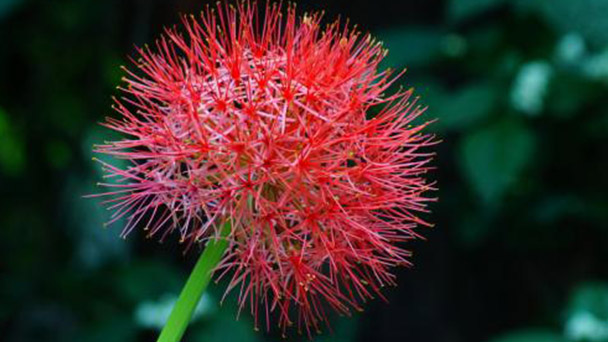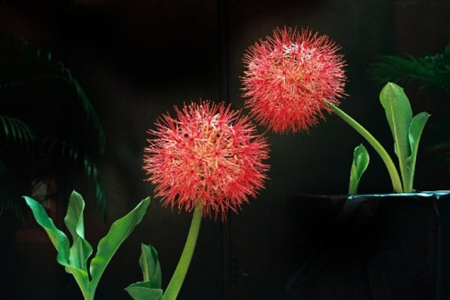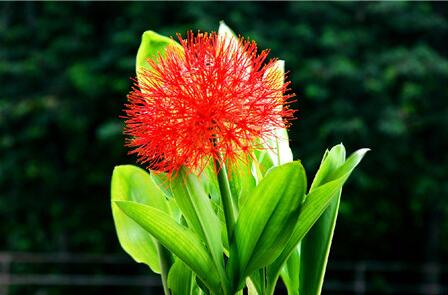Scadoxus multiflorus profile
Written by Maggie
Jan 07 2021

Scadoxus multiflorus, scientific name Haemanthus multiflorus Martyn, is a perennial herbaceous bulbous flower of the genus Scadoxus Multiflorus in Lycoris family. Scadoxus multiflorus has a flat globular bulb with leaves drawn from the short upper stem in late spring as the temperature rises, and is striped. When the leaf blade reaches 4-5, then spathe spathe, the style has light green spathe below. Globular umbel terminal, there are dozens to hundreds of inflorescences, flowers are bright red, stamens longer than perianth, anthers yellow, look radiate like a ball. It only blooms once a year, and the flowering period is from May to July. A flower bulb lasts only about 10 days. After the flowers fade, it bears round berries.
Scadoxus multiflorus is originally from the tropics. It likes warm, humid and semi-cloudy environments, and is afraid of heat and cold. It has been introduced and cultivated in China for ornamental use.
Scadoxus multiflorus picture

Ecological habit of Scadoxus multiflorus
Scadoxus multiflorus likes a warm, humid and semi-cloudy environment. It is not cold tolerant and has a tropical temperature of 16-21℃ during its growing period. The temperature in winter should not be lower than 5℃, and loose sandy loam is the best soil.
Morphological characteristics of Scadoxus multiflorus
Scadoxus multiflorus is a perennial herb.Up to 80-90 cm, bulbs oblate globose, ca. 7 cm in diam. Leaves are extracted from the short stem above the bulb, 3-6, often collected from the upper part of the stem, elliptic to rectangular, up to 30 cm long, entirely. Stems are 30-90 cm tall, first leaves extracted, green with purple spots.Inflorescences globose umbels terminal, 15 cm in diameter, 30-100 florets, blood red, flowering May - June.
Main origin of Scadoxus multiflorus
Scadoxus multiflorus is native to tropical Africa.
Scadoxus multiflorus cultivation methods
Every year spring planting, basin soil requirements loose and fertile, good drainage. In the germinating leaf period, apply fertilization 1 time every ten days. When the summer light is too strong, put half shade conservation. In summer flowering, put it in a cool place, can prolong the flowering period. In autumn when the piece begins to wilt yellow, reduce watering. When the bulb comes into dormant period, we should stop watering, keep the soil dry and dig out the bulb storage indoors.
Scadoxus multiflorus is warm and moist with a suitable growth temperature of 16~21℃ and is afraid of direct sunlight. In spring and autumn, it is placed in half shade for cultivation. In summer, it is moved to a cool and ventilated place with shade to avoid strong light exposure, otherwise it is easy to burn the leaves.
In the spring, when changing the pot, you need to apply sufficient base fertilizer, and wait for the bud of the bulb to be excavated before topdressing.
After the scape appears, we should strengthen the light, usually to keep the pot soil moist. On rainy days, do not make the pot water, in order to prevent rotting roots and rotten bulbs.

In the winter leaves wither, bulbs dormant in the soil for the winter, do not water and fertilize.
In spring, the small ball on the cue ball is separated from the planting, the growing season needs to see dry and then water. It is better to dry, apply 1 time of compound fertilizer every 2 weeks, to promote large flowers, colorful, long flowering periods.
Potting requires the selection of loose and fertile, drainage unblocked culture soil, and on the bottom of the pot spread about 3cm of slag or small stones, for drainage. If the basin water easily causes root injury.
When flowering, place it in a lower temperature place, and can extend the tube flowering period.
In east China, November leaves began to yellow into the dormant period. During this period, we should control watering, keep the basin soil slightly wet, even the basin together with not less than 5℃ indoor overwintering.
Generally, the mature plants should be sprayed once a year in spring. When replacing the pot, part of the dead roots should be cut off and new culture soil should be added to facilitate the germination of new roots, so that the plants can grow healthfully and have abundant flowers and leaves.
Scadoxus Multiflorus garden use
Scadoxus multiflorus is a gorgeous flower with red, white and bright red colors. Dense flowers, such as balls, are common indoor potted ornamental open flowers. Outdoor cluster planting in the south is arranged in pieces, and the flowering landscape has a unique style.

Latest Updated
- Benefits of Bugleweed - 7 Science-backed Health Benefits
- Bugleweed Dangers & Side Effects - Is It Poisonous?
- How to Plant Evergreen Trees - What You Should Know
- When to Plant Evergreens - Grow Guide for Evergreen Trees
- 12 Wonderful Evergreen Shrubs for Your Garden
- 12 Popular Evergreen Plants with Pictures for Beginners
- When And How To Prune A Lilac Bush Like a Pro
- How to Grow & Care for Lilac Vine (Hardenbergia Violacea)
- Japanese Lilac Tree (Syringa Reticulata) Care & Propagation Guide
- Shumard Oak Pros and Cons - What to Know
Popular Articles
- Winter maintenance of Antirrhinum Majus
- How to Grow Terminalia Mantaly Tree
- How to Grow and Care for Crossostephium Chinense
- How to grow Antirrhinum Majus in spring
- Peristeria Elata (Dove Orchid) Profile: Info & Care Guide
- Underwatered Snake Plant (Sansevieria Trifasciata) - Signs And How To Fix
- How to Care for Brazilian Jasmine Plant (Mandevilla Sanderi)
- How to Grow & Care for Graptopetalum Purple Delight in Summer
- Rosa Chinensis (China Rose): Plant Growing & Care Tips
- How to Care for Baby Sun Rose (Aptenia Cordifolia)